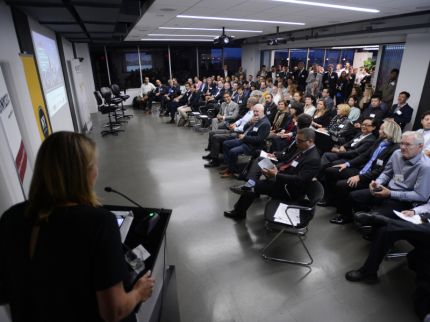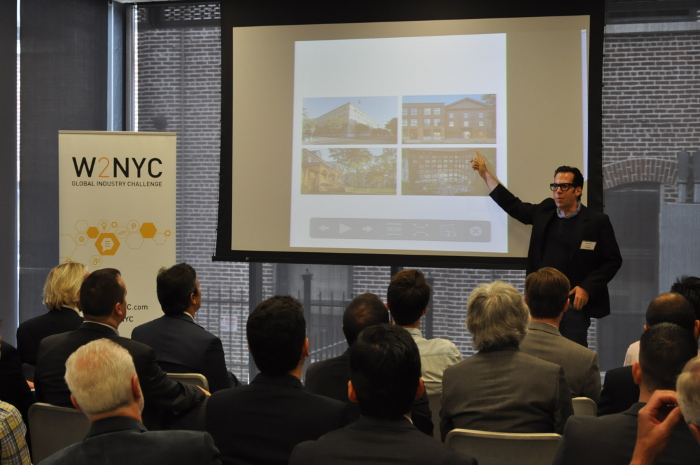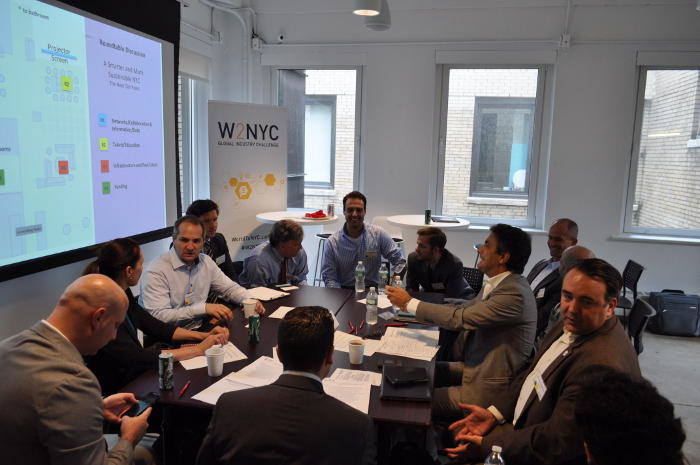
W2NYC Fall program concluded: New York City CTO Minerva Tantoco: “New practices are needed for the way we apply technological advances to city management” The keynote address of the World to NYC (W2NYC) program last week was by Minerva Tantoco, New York City’s new Chief Technology Officer. Ms. Tantoco addressed the group of W2NYC delegate companies, partners, and guests by introducing her tech background saying that she believes the city can benefit from implementing new technologies—such as those the W2NYC delegate companies offer—faster than it does presently. A born New Yorker, Ms. Tantoco spent a major part of her career living and working internationally and she stressed the fact that international hubs can learn from and exchange ideas with each other.During the capstone event, the fifteen chosen delegate companies were able to present their smart and sustainable city solutions in front of a panel of expert judges. The winner received a trip to the Smart City Expo World Congress in Barcelona on November 18-20, 2014 and three runners-up received two months of free office space in the Urban Future Lab in Brooklyn. OptiRTC, a system which controls the flow of storm water in cities to eliminate pollution of natural water bodies, won the first prize.Ms. Tantoco’s talk was one of the highlights during a full three-day World to NYC program. The 15 globally-selected companies as well as program partners kicked off the first series of events at three locations in Brooklyn. The focus was on what smart city solutions can offer New York City to save energy, plan and monitor traffic more effectively, and upgrade to a smart infrastructure.During the informal opening session the delegate companies learned to refine their pitches before presenting to city representatives, partners, customers, investors, and media. Sang Ahn, head of the Open Innovation Center in the Northeast for Samsung, listened to 15 pitches and provided feedback.His key points for pitching in the US:
The keynote address of the World to NYC (W2NYC) program last week was by Minerva Tantoco, New York City’s new Chief Technology Officer. Ms. Tantoco addressed the group of W2NYC delegate companies, partners, and guests by introducing her tech background saying that she believes the city can benefit from implementing new technologies—such as those the W2NYC delegate companies offer—faster than it does presently. A born New Yorker, Ms. Tantoco spent a major part of her career living and working internationally and she stressed the fact that international hubs can learn from and exchange ideas with each other.During the capstone event, the fifteen chosen delegate companies were able to present their smart and sustainable city solutions in front of a panel of expert judges. The winner received a trip to the Smart City Expo World Congress in Barcelona on November 18-20, 2014 and three runners-up received two months of free office space in the Urban Future Lab in Brooklyn. OptiRTC, a system which controls the flow of storm water in cities to eliminate pollution of natural water bodies, won the first prize.Ms. Tantoco’s talk was one of the highlights during a full three-day World to NYC program. The 15 globally-selected companies as well as program partners kicked off the first series of events at three locations in Brooklyn. The focus was on what smart city solutions can offer New York City to save energy, plan and monitor traffic more effectively, and upgrade to a smart infrastructure.During the informal opening session the delegate companies learned to refine their pitches before presenting to city representatives, partners, customers, investors, and media. Sang Ahn, head of the Open Innovation Center in the Northeast for Samsung, listened to 15 pitches and provided feedback.His key points for pitching in the US:
- Make your product really clear—and don’t assume anything.
- Buy yourself attention, 10 seconds at a time.
- Try to use key phrases that resonate. For instance “recognized by,” “different to existing solutions because,” “patent issued,” “proprietary,” “units sold/installed,” “partner to,” etc.
In the opening session at The Urban Future Lab NYCEDC’s Director of International Affairs, Gianluca Galetto, and NYCEDC’s EVP and Managing Director for the Center for Economic Transformation, Eric Gertler, praised the program and the winning companies. “With more than 30 global partners, the World to NYC program is a prime example for collaboration between the private, public, and civic sector,” Mr. Galletto said. It was followed by a discussion between two successful clean tech companies that have made NYC their home at the Urban Future Lab.
| “In the clean energy sector, a true partnership approach is needed; from cost sharing and software licensing, to helping your partner to innovate.” |
First, Bob Currie, CTO of Smarter Grid Solutions mentioned two key reasons why picking New York City as the US headquarters for his Scottish company. After Sandy, the funding and the interactions in the city were very open and dynamic—something that took years in the UK. A flagship project with ConEdison and a place in ACRE—the NYC cleantech accelerator—enabled the company to be successful in New York City and they are now employing more than 40 people. The key learning for him: in the clean energy sector, a true partnership approach is needed; from cost sharing and software licensing, to helping your partner to innovate. Nick Blitterswyk, of CEO UGE International, added that New York City’s amazing diversity enabled his company to work in over 90 countries, as people want to work in NYC and travel through NYC all the time. Challenges for both companies included the dynamic and fluid way business is being conducted in the city, making it mandatory to spend time here.The focus at the Brooklyn Navy Yard—formerly a ship building yard which has been turned into a state-of-the-art industrial park with over 4 million square feet of space—was on the New Lab’s approach to innovation and the companies that call it home. David Belt, co-founder of New Lab explained their approach to hardware ventures, saying that they want to be like the “nondenominational MIT Media Lab” or the MIT Media Lab without having to live in Boston. Belt listed a few reasons why NYC was chosen as the ideal place to start New Lab, among them the fact that density and diversity leads to true ingenuity. Brooklyn Navy Yard today is home to many green and sustainable projects, from farms on rooftops to new bike sharing prototypes. Following more than twenty talks and meetings, the delegates were asked to suggest their ideas on how to make New York City smarter when it comes to infrastructure and real estate, talent and education, and funding new ventures. Findings included quotes such as, “The city is doing the right thing, but New Yorkers care about food and are just too busy to care about sustainability. That has to change,” and “smarter regulation is needed to leverage new solutions for the city like Uber or Airbnb.”One key quote that summarized the benefit of being in New York City. “If you succeed in NYC, other cities and partners will pay attention. It’s as simple as that.”
Following more than twenty talks and meetings, the delegates were asked to suggest their ideas on how to make New York City smarter when it comes to infrastructure and real estate, talent and education, and funding new ventures. Findings included quotes such as, “The city is doing the right thing, but New Yorkers care about food and are just too busy to care about sustainability. That has to change,” and “smarter regulation is needed to leverage new solutions for the city like Uber or Airbnb.”One key quote that summarized the benefit of being in New York City. “If you succeed in NYC, other cities and partners will pay attention. It’s as simple as that.”
